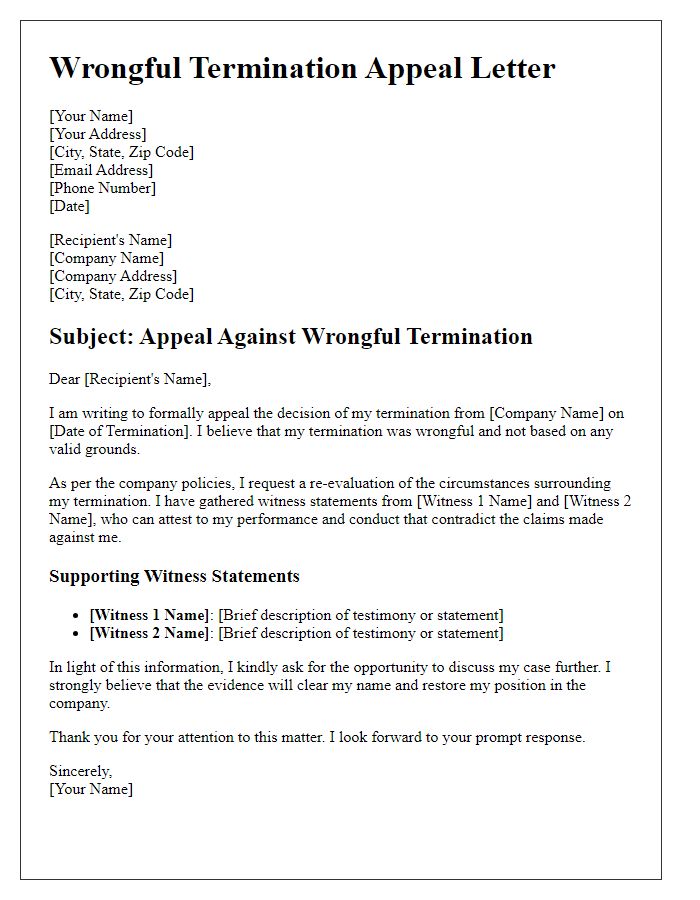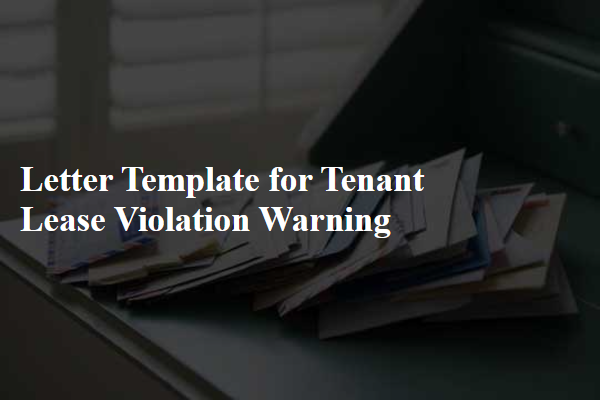If you've found yourself facing wrongful termination, writing an appeal letter can feel overwhelming, but it doesn't have to be. This is your chance to clearly outline your situation and present evidence of your unfair dismissal in a way that resonates. Crafting a compelling narrative can significantly improve your chances of a favorable outcome. So, let's dive into the essential elements of an effective appeal letter and explore how you can make your voice heard!

Employee Information
The process of appealing a wrongful termination can be crucial for employees seeking justice. Important factors include the employee's name, identification number, position held at the company, and the date of termination. Additionally, relevant details about the employer, such as company name, contact information, and the manager's name involved in the termination decision, provide context. The appeal should reference policies outlined in the employee handbook regarding termination procedures, along with the circumstances surrounding the termination, including date of incident, events leading up to the decision, and any evidence supporting claims of wrongful dismissal. Clarity and conciseness in the appeal can significantly enhance its effectiveness.
Incident Description
The incident leading to the wrongful termination occurred on March 15, 2023, at XYZ Corporation, a well-known technology firm located in San Francisco, California. The employee, Jane Doe, was unjustly terminated from her position as a Senior Software Developer after raising concerns about workplace harassment from a colleague, John Smith. Despite following the appropriate grievance procedures outlined in the employee handbook, Jane was met with retaliation, which culminated in her abrupt dismissal. During a team meeting on March 10, 2023, Jane provided detailed evidence of the harassment, including dates, times, and witness accounts, but instead of addressing the issue, management chose to silence her. The wrongful termination not only violated California's labor laws aimed at protecting whistleblowers but also showcased a neglect of employee rights, creating a toxic work environment that dissuades reporting misconduct.
Supporting Evidence
The appeal for wrongful termination requires robust supporting evidence to substantiate claims of unfair dismissal. Key documents include the termination letter, which should detail reasons for dismissal, often issued by human resources departments of companies such as XYZ Corporation. Employment records like pay stubs from the last quarter provide proof of employment and duration of service, while performance evaluations highlight job competency and contributions to the organization. Witness statements from colleagues, particularly those who can corroborate positive work behavior or falsity of allegations leading to termination, lend credibility. Any applicable employment contracts or company policies outlining termination procedures, especially those breached during the firing process, must be included to show procedural discrepancies. Additionally, correspondence pertaining to the events leading to termination, such as emails or meeting notes, can illustrate a timeline of interactions or disputes. Documentation of similar cases within the organization, if available, provides context and supports claims of discriminatory practices.
Legal References
Wrongful termination appeals often reference specific legal statutes and precedents that support the claim. The employment law framework in the United States includes the Civil Rights Act of 1964 (Title VII), which prohibits employment discrimination based on race, color, religion, sex, or national origin. Additionally, the Age Discrimination in Employment Act (ADEA) protects employees aged 40 and older from discrimination based on age. Several states have their own labor laws that may provide broader protections, such as California's Fair Employment and Housing Act (FEHA). Courts have established critical legal precedents, such as "McDonnell Douglas Corp. v. Green," which outlines the burden-shifting framework for proving discrimination claims. Furthermore, whistleblower protections under the Whistleblower Protection Act protect employees who report violations of laws or regulations from retaliation. Including these references strengthens the appeal by demonstrating alignment with established legal principles and affirming the validity of the wrongful termination claim.
Request for Resolution
A wrongful termination appeal denotes an employee's formal request to reconsider a dismissal deemed unjust. The importance of this process lies in its potential to rectify workplace injustices, ensuring adherence to labor laws prevalent in the jurisdiction, such as the Fair Labor Standards Act (FLSA) in the United States. Employees often present evidence, including performance reviews and witness statements from colleagues, to substantiate claims. Timely filing, typically within 30 days post-termination, aligns with most organizational policies. Human Resources departments, responsible for handling such grievances, play a critical role in mediating these appeals. Moreover, legal representation may enhance the appeal's success, especially when navigating complex labor law statutes. The outcome could lead to reinstatement, financial compensation, or other remedies, emphasizing the significance of this appeal process in the workplace.
Letter Template For Wrongful Termination Appeal Samples
Letter template of wrongful termination appeal based on violation of company policy.

Letter template of wrongful termination appeal citing breach of contract.

Letter template of wrongful termination appeal for retaliation against whistleblowing.

Letter template of wrongful termination appeal after a false accusation.

Letter template of wrongful termination appeal involving insufficient evidence.

Letter template of wrongful termination appeal highlighting lack of proper procedures.

Letter template of wrongful termination appeal concerning job performance misinterpretation.

Letter template of wrongful termination appeal with supporting witness statements.






Comments